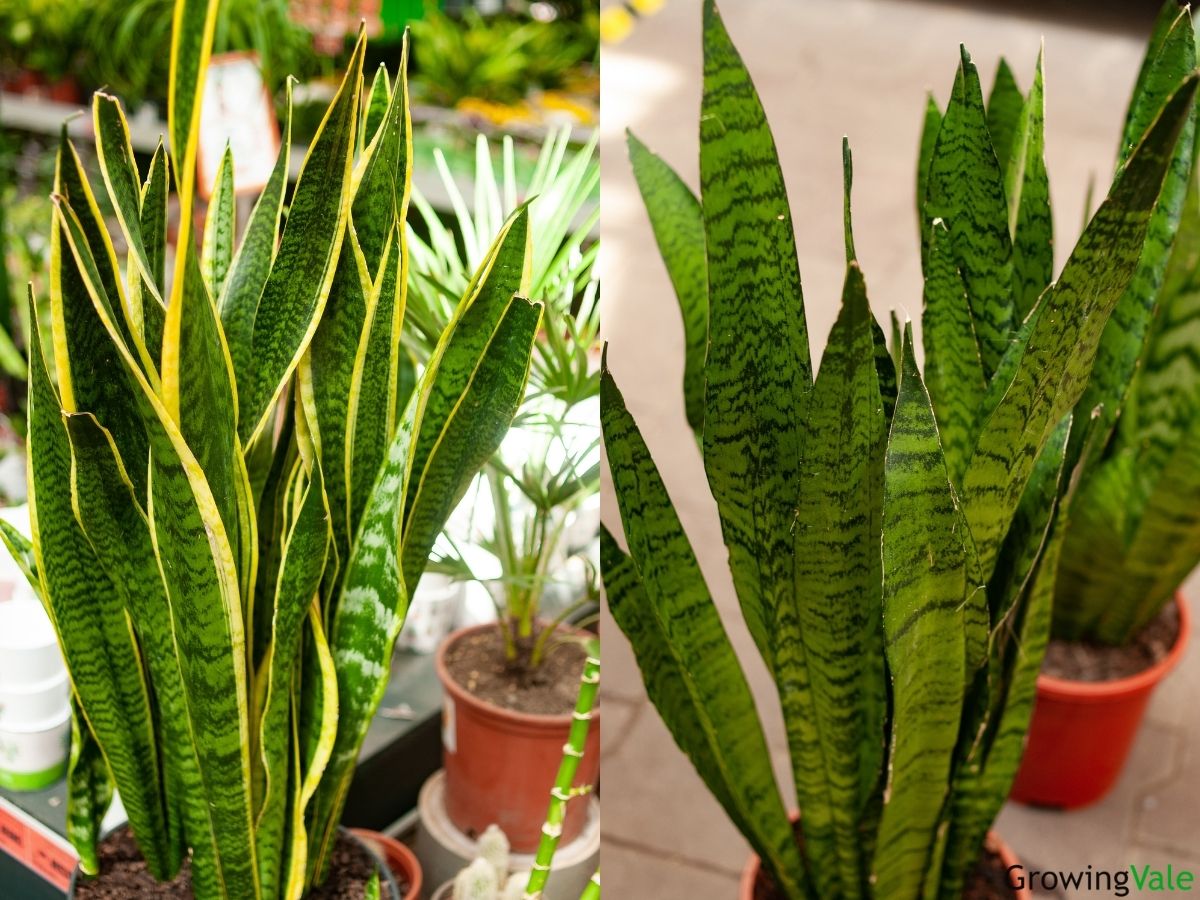With striking sword-shaped leaves in shades of green, yellow, and cream, the snake plant is an eye-catching houseplant. Also known as sansevieria or mother-in-law’s tongue, over 70 species and cultivars of this hardy succulent exist.
Below you’ll find a visual guide featuring beautiful photos of popular snake plant types to help you identify the amazing variety within this species
A Closer Look at Snake Plant Leaves
Snake plants showcase a range of fascinating leaf characteristics:
-
Shape – From short and fat, to tall and slender, leaf shape varies dramatically. Some have cylindrical, rounded leaves while others have flat, pointed foliage.
-
Color – Shades of green, from deep emerald to light lime, are most common but silver, gold, and cream varieties also occur. Some feature bold yellow or white vertical striping.
-
Pattern – Leaves may be solid colored or showcase intricate variegation, mottling, margins, and stripes. The contrast makes these plants truly stand out.
-
Texture – Smooth or lightly rippled leaves give snake plants a touchable appearance Some also develop wrinkled horizontal ridges as they mature.
10 Beautiful and Unique Snake Plant Types
-
Dracaena trifasciata – This upright, green-leaved plant with ribbed foliage is the classic snake plant found in many homes. It can grow over 4 feet tall at maturity.
-
Dracaena trifasciata ‘Laurentii’ – One of the most popular varieties, this has green leaves striped with bright yellow along the edges The coloring is stunning.
-
Dracaena trifasciata ‘Moonshine’ – Silvery blue-green leaves give this aptly named cultivar a luminous glow. The leaves turn darker green as they age.
-
Dracaena trifasciata ‘Bantel’s Sensation’ – Thinner, more upright leaves display eye-catching white vertical stripes on dark green. Truly sensational!
-
Dracaena cylindrica – As its name suggests, the leaves on this species are cylindrical and rounded rather than flat. The texture is unique and full.
-
Dracaena angolensis ‘Boncel’ – Also known as starfish sansevieria, its short, stubby leaves radiate out in a rosette shape resembling a starfish.
-
Dracaena trifasciata ‘Hahnii’ – Minimalists will love this compact cultivar. It stays under a foot tall with rosettes of short, clustered leaves.
-
Dracaena trifasciata ‘Golden Hahnii’ – A bright variation of above with golden yellow margins around the leaves for added pizzazz. Stunning as a tabletop accent.
-
Dracaena masoniana – Thick paddle-shaped leaves can reach over 5 feet tall on this imposing snake plant. It’s also called whale fin sansevieria.
-
Dracaena masoniana ‘Variegata’ – The whale fin snake plant with bold yellow striping along the dramatic arched foliage. It’s love at first sight!
Using Color and Pattern in Snake Plant Design
Beyond appreciating their inherent beauty, consider how you can incorporate different snake plant varieties into your interior designs:
-
Use solid green varieties like D. trifasciata as neutral foundation plants. Provide contrast with brightly patterned cultivars.
-
Let the yellow margins of D. trifasciata ‘Laurentii’ and similar varieties brighten shady spots.
-
Make a bold statement by highlighting the striking white stripes of D. trifasciata ‘Bantel’s Sensation’.
-
Contrast the tall shape of D. trifasciata with low rosette types like D. trifasciata ‘Hahnii’.
-
Combine rounded and cylindrical leaves for added interest.
Caring for Your Snake Plant Collection
While adaptable to most indoor conditions, snake plants thrive with:
-
Bright indirect light – Near an east or west window is ideal. Provide sheer curtains in south facing spaces.
-
Moderate water – Allow soil to dry out between waterings. Water thoroughly until it drains from the pot.
-
Well-draining potting mix – Use a cactus/succulent soil or amend with sand, perlite, or orchid bark.
-
Consistent warmth – Average room temps of 65°F-80°F suit them well. Avoid cold drafts.
-
Humidity – Enjoy more lush growth by providing 40-50% humidity. Use a humidifier if your home is very dry.
-
Occasional fertilizer – Feed monthly in spring and summer with a balanced liquid fertilizer.
Snake plants are not prone to many issues, but may develop brown tips from dry air or root rot from overwatering. Overall they are delightful low maintenance houseplants!
Let this visual guide inspire you to appreciate and collect the myriad snake plant species and cultivars that exist. With proper care, you can create an ever-changing display as your plants mature over time.
15 types of snake plant varieties to grow indoor
FAQ
Is it good to have a snake plant in the house?
Do snake plants prefer sun or shade?
How do I identify a snake plant?
What kind of leaves do snake plants have?
Some snake plant varieties have a long sword-shaped flat green leaves. Other tropical sansevieria varieties such as sansevieria cylindrica (African spear plant), and starfish sansevieria have cylindrical round leaves with pointed ends.
What is a snake plant called?
Related: Mother-in-Law’s Tongue (Snake Plant): Care and Growing Guide Related articles: Snake plant (sansevieria) varieties (also named ‘viper’s bowstring hemp’). Including plant care guide, pictures and common plant names.
How many snake plant stock photos are there?
Browse 12,828 authentic snake plant stock photos at Getty Images. Find the right photo at the right size and resolution for your project, or explore additional sansevieria or mother in laws tongue stock images.
How many types of snake plants are there?
This blog post features 32 different types of snake plants, all with pictures for easy identification. From the common Sansevieria trifasciata to the more exotic Sansevieria raffillii, there’s sure to be a snake plant here that catches your eye.

